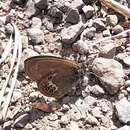en
names in breadcrumbs


The Scarce Heath occurs in damp to wet grassy meadows in or at the edges of woods. Sometimes, they occur away from woods in drier places or in flower-rich grassland. The butterflies are fond of settling in grass and do not fly far, nor very often. Among the grasses they use as food are Tufted Hair-grass (Deschampsia cespitosa) and Bearded Couch (Elymus caninus). When half-grown, the caterpillar hibernates in a grass tussock, later also pupating there. This species has one generation a year. Habitats: humid grasslands and tall herb communities (26%), mixed woodland (19%), broad-leaved deciduous forests (14%), mesophile grasslands (9%), fens, transition mires and springs (7%).
Coenonympha hero, the scarce heath, is a butterfly species belonging to the family Nymphalidae.
It can be found in Central Europe, Northern Europe and the North Palearctic (Urals East to Mongolia, Korea and Japan).
It resembles Coenonympha arcania.In Seitz it is described "On the upperside resembles Coenonympha oedippus smaller and just as dark, but on the hindwing 2 or 3 ocelli shine through from beneath as yellowish brown rings. On the underside itself the ocelli are placed in orange rings, and on their basal side there is a straight white line, which is thickened into knots on the veins. Northern and Central Europe and the whole of Northern Asia, from Sweden as far as the Alps, and from Belgium eastwards to the Pacific Ocean and Japan. ab. stolida Schilde, from Scandinavia, is smaller and darker, and the forewing bears a white distal band on their underside. In ab. perseis Led. [subspecies] (= sibirica Stgr.) (48a), which in Eastern Asia occurs among the nymotypical form, but locally also flies alone, the white band before the row of ocelli on the underside of the hindwing is much widened. — Fruhstorfer separates from this form, as neoperseis[subspecies], the specimens from Hokkaido, which are larger. — In ab. areteoides Fol., which is recorded from Belgium, the ocelli on the hindwing are obsolete. — Larva pale green, on lyme-grass (Elymus) and wood-grasses. In Europe the butterflies are on the wing in June and July, in Eastern Asia according to Graeser in two broods; in woods of leaved trees and in meadows « overgrown with bushes. The specimens of hero rise higher in the air in their flight than the pale species of Coenonympha, and slightly recall small Erebias; they occur more singly and usually very locally, and one does not easily catch more than a few specimens in one day. [1]
The butterflies fly in one generation from May to July.
The larvae feed on various grasses.
Named in the Classical tradition.Hero was a Greek scholar.
Coenonympha hero, the scarce heath, is a butterfly species belonging to the family Nymphalidae.